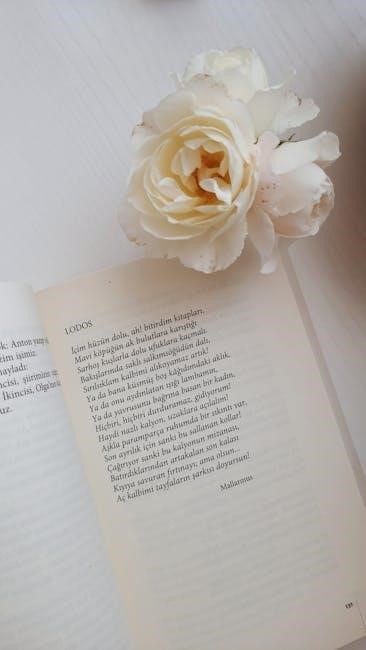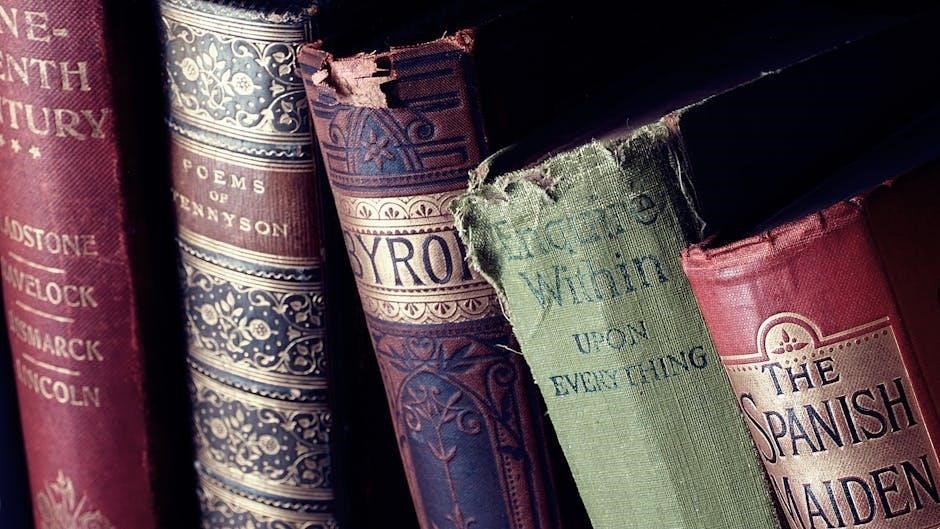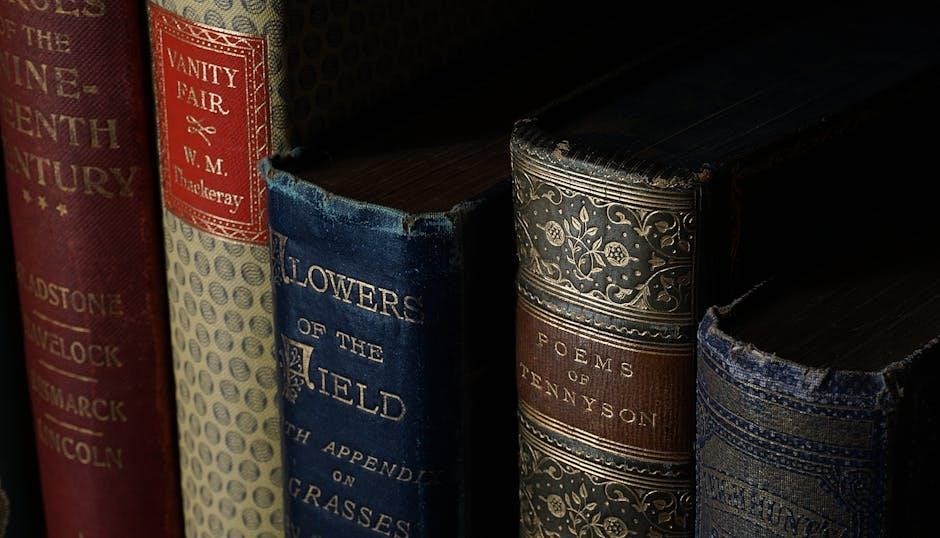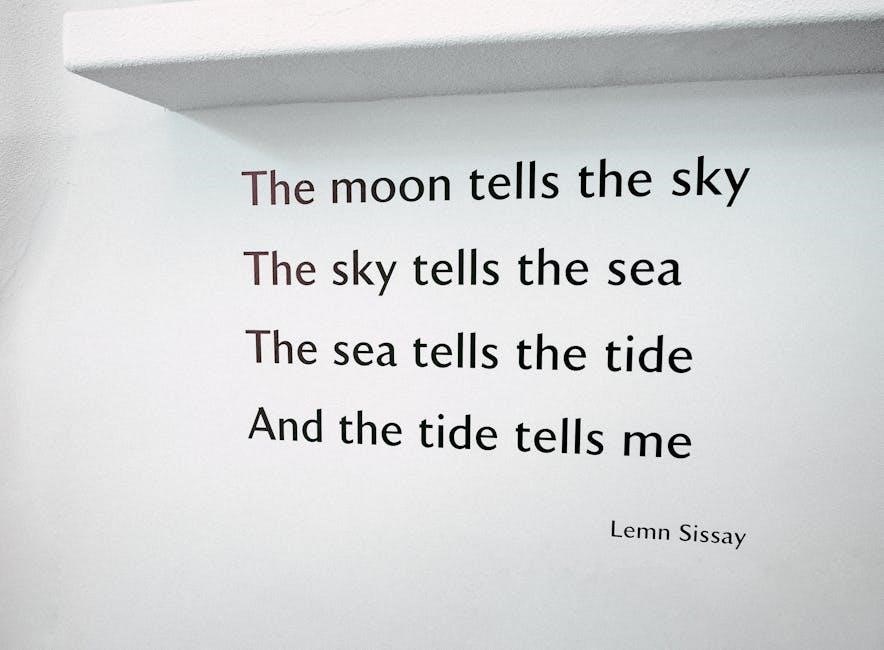
emily dickinson poems pdf
Download Emily Dickinson poems in PDF for free. Explore her iconic poetry collection and read her timeless masterpieces anywhere.
Emily Dickinson’s poems, now widely available in PDF formats, offer readers a unique glimpse into her profound and intimate world of thought, nature, and emotion, preserving her timeless appeal for modern audiences seeking accessible and portable literary treasures.
Brief Overview of Emily Dickinson’s Life and Work
Emily Dickinson (1830–1886) was a 19th-century American poet known for her unique and innovative style. Born in Amherst, Massachusetts, she lived a reclusive life, rarely leaving her family’s Homestead. Dickinson’s poetry, largely unpublished during her lifetime, gained recognition posthumously, revealing her profound exploration of themes like death, nature, and inner conflict. Her work, often written in unconventional meter and structure, reflects her introspective and enigmatic personality. Today, her poems are widely celebrated, and their accessibility in PDF formats has made her legacy more reachable to modern readers, ensuring her enduring influence on American literature and poetry.

The Unique Style of Emily Dickinson’s Poetry
Emily Dickinson’s poetry is renowned for its innovative and unconventional style, which sets her apart from her contemporaries. Her use of irregular meter, slant rhyme, and dashes creates a rhythmic yet fragmented flow, mirroring her exploration of complex emotions and ideas. Capitalization and imagery add depth, while her concise yet profound language captures universal themes. This distinctive approach, often described as enigmatic and intimate, invites readers to interpret her work personally. The availability of her poems in PDF formats has made her unique style more accessible, allowing modern readers to engage with her groundbreaking techniques and poetic genius in a convenient digital form.
Why Her Poems Remain Relevant Today
Emily Dickinson’s poems endure as timeless reflections on universal themes, resonating with modern readers through their exploration of death, nature, love, and isolation. Her unique style, marked by dashes and unconventional capitalization, invites contemporary interpretations, making her work a subject of ongoing scholarly and artistic fascination. The availability of her poetry in PDF formats has further enhanced accessibility, allowing global audiences to engage with her profound insights. Themes like inner conflict and the search for meaning continue to captivate, while her reclusive life adds an air of mystery, inspiring new adaptations and literary explorations. Dickinson’s poetry remains a cornerstone of American literature, offering solace, inspiration, and intellectual stimulation to readers across generations.
The Life and Times of Emily Dickinson

Emily Dickinson lived a reclusive life in Amherst, Massachusetts, surrounded by nature and family, her unique poetry reflecting her inner world and timeless connection to humanity.
Early Life and Family Background
Emily Dickinson was born on December 10, 1830, in Amherst, Massachusetts, to Edward and Emily Norcross Dickinson. Her father, a prominent lawyer and treasurer of Amherst College, provided a stable and educated household. Dickinson had two younger siblings, Austin and Lavinia. Her early life was marked by a close-knit family and a deep connection to her hometown, which later influenced her reclusive lifestyle. She attended Mount Holyoke Female Seminary (now Mount Holyoke College) but did not graduate, preferring to focus on her private studies and writing. This foundation shaped her unique perspective and poetic voice, reflecting both her inner world and the external surroundings of her family’s Homestead.
Her Reclusive Lifestyle and Creative Process
Emily Dickinson’s reclusive lifestyle profoundly shaped her creative process, as she rarely left her family’s Homestead in Amherst, Massachusetts. Her days were spent in solitude, surrounded by nature, which deeply influenced her poetry. Despite her isolation, Dickinson maintained a prolific writing routine, often composing poems in the early morning or late at night. Her reclusive nature allowed her to focus inward, exploring themes of death, love, and spirituality. The Homestead became her creative sanctuary, where she crafted her unique, enigmatic style. Dickinson’s seclusion not only defined her life but also fueled her artistic genius, leaving behind a legacy of poetry that continues to captivate readers in PDF collections and beyond.
Death and Posthumous Recognition
Emily Dickinson passed away on May 15, 1886, in Amherst, Massachusetts, leaving behind a trove of unpublished poems. Her reclusive life meant her work was largely unknown during her lifetime. After her death, her sister Lavinia discovered the extensive collection of poems Emily had written, leading to their posthumous publication. Initially, editors altered her unique style to conform to traditional poetic norms, but her original voice gained recognition over time. Today, her poetry is celebrated for its profound exploration of death, nature, and inner conflict. The annual Tell It Slant Poetry Festival in Amherst and exhibitions like the one at the Morgan Library highlight her enduring legacy, ensuring her work remains a vital part of American literary history.

Themes in Emily Dickinson’s Poetry
Death and Immortality
Emily Dickinson’s poems explore profound themes like death, nature, love, and isolation, offering deep emotional and philosophical insights that resonate universally, especially in accessible PDF formats today.
Death and Immortality
Emily Dickinson’s poems frequently grapple with the themes of death and immortality, offering profound reflections on life’s transient nature. Her unique perspective often personifies death, as seen in “Because I Could Not Stop for Death,” where it is depicted as a courteous suitor. Dickinson’s exploration of mortality transcends fear, instead embracing it as a natural part of existence. Her poetry delves into the mysteries of the afterlife, questioning what lies beyond the grave. This fascination with immortality is intertwined with her observations of nature, where cycles of life and death serve as metaphors for eternal truths. Dickinson’s poems, now widely accessible in PDF formats, continue to captivate readers with their timeless meditations on death and the enduring human spirit.
Nature and Its Symbolism

Emily Dickinson’s poetry is deeply intertwined with nature, which she often used as a mirror to reflect human emotions and existential themes. Her backyard in Amherst became a sanctuary, inspiring vivid imagery and symbolism. Flowers, seasons, and animals appear frequently, serving as metaphors for life, death, and spirituality. For instance, autumn symbolizes decline and transformation, while birds embody freedom and hope. Dickinson’s unique perspective on nature, as seen in her reclusive yet observant lifestyle, allowed her to craft poems that resonate universally. The accessibility of her work in PDF formats has made it easier for readers to explore her natural world, where every element carries profound meaning, inviting reflection on the human condition and the mysteries of existence.
Love, Isolation, and Inner Conflict
Emily Dickinson’s poetry masterfully explores themes of love, isolation, and inner conflict, reflecting her reclusive life and profound emotional depth. Her poems often express a longing for connection, yet a simultaneous withdrawal from the world, creating a sense of duality. The isolation she embraced allowed her to delve deeply into her inner self, producing works that resonate with universal human experiences. Her vivid imagery and symbolism convey the tension between desire and solitude, offering readers a window into her complex psyche. This duality is a hallmark of her poetry, making her works timeless and relatable, even in modern times.

The Structure and Style of Her Poems
Emily Dickinson’s poetry is renowned for its unconventional meter, imagery-rich symbolism, and distinctive dashes, creating a unique rhythm that reflects her innovative and deeply personal artistic voice.
Unconventional Use of Meter and Rhyme
Emily Dickinson’s poetry is renowned for its unconventional use of meter and rhyme, which sets it apart from traditional 19th-century verse. She often employed a hymn-like meter but altered it to suit her unique expression, creating a rhythmic irregularity that mirrored her emotional depth. Her use of slant rhyme, or near-rhyme, added complexity and subtlety to her work, allowing for a more personal and intimate tone. These innovations, now easily accessible in PDF formats of her poems, showcase her bold departure from poetic norms. Dickinson’s experimentation with form and sound not only reflected her individuality but also expanded the possibilities of poetic expression, leaving a lasting influence on modern poetry. Her unconventional style continues to captivate readers, offering a fresh perspective on themes like death, nature, and inner conflict.
Imagery and Symbolism in Her Work
Emily Dickinson’s poetry is renowned for its vivid imagery and profound symbolism, which invite readers to explore deeper meanings. Her poems often depict nature—flowers, birds, seasons—as metaphors for life, death, and eternity. For instance, “Hope is the Thing with Feathers” uses a bird to symbolize hope’s gentle yet enduring presence. Dickinson’s unique style, including unconventional capitalization and dashes, enhances the imagery, creating a sense of immediacy and intimacy. These elements, now easily accessible in PDF formats, allow modern readers to engage with her symbolic language and interpret her timeless themes. Her mastery of imagery and symbolism continues to captivate audiences, making her poetry a cornerstone of American literature.
The Role of Dash and Capitalization
Emily Dickinson’s poetry is renowned for its unconventional use of dashes and capitalization, which add emotional depth and disrupt traditional poetic structures. Her dashes often replace punctuation, creating pauses that mirror natural speech, while her capitalization emphasizes key words, reflecting her innovative style. These stylistic choices enhance the intimacy and immediacy of her work, making her poems feel deeply personal and modern. In PDF formats, these unique elements are preserved, allowing readers to experience her groundbreaking technique firsthand. Dickinson’s use of dashes and capitalization remains a defining feature of her poetry, contributing to its enduring appeal and thought-provoking nature.
Emily Dickinson’s Legacy
Emily Dickinson’s legacy endures through her poems in PDF formats, ensuring her timeless themes and unique style remain accessible, inspiring new generations of readers and scholars alike.

Her Impact on American Literature
Emily Dickinson’s poetry has left an indelible mark on American literature, reshaping traditional forms and themes with her unique voice and vision. Her unconventional style, exploring themes of death, nature, and inner conflict, broke away from 19th-century poetic norms, influencing generations of writers. As a key figure in American poetry, Dickinson’s work has been celebrated for its depth, originality, and emotional resonance. Her poems, now widely accessible in PDF formats, continue to inspire modern readers and scholars, solidifying her legacy as one of the most important American poets. Dickinson’s innovative approach to language and structure has made her a timeless icon, ensuring her relevance in contemporary literary discussions and studies.
Modern Interpretations of Her Poetry
Emily Dickinson’s poetry continues to inspire modern interpretations, with readers and scholars exploring new perspectives on her themes of death, nature, and isolation. The rise of digital formats, such as PDF collections, has made her work more accessible, allowing contemporary audiences to engage with her unique style and profound insights. Recent exhibitions, like the one at the Morgan Library, and works like Nuala O’Connor’s novel Miss Emily, reimagine her life and poetry for today’s readers. The Tell It Slant Poetry Festival further celebrates her enduring influence, showcasing how her poetry remains a vibrant force in modern literary culture. Her timeless themes resonate anew in a digital age.
Cultural and Historical Significance
Emily Dickinson’s poetry holds profound cultural and historical significance, offering insights into 19th-century American life and thought. Her unique voice and themes, such as death, nature, and isolation, resonate universally, making her a cornerstone of American literature. The availability of her poems in PDF formats has ensured their preservation and accessibility, allowing modern readers to connect with her timeless reflections. Dickinson’s work not only mirrors her reclusive life but also challenges societal norms, cementing her legacy as a cultural icon. Her influence extends beyond literature, inspiring festivals like the Tell It Slant Poetry Festival, which celebrates her enduring impact on poetry and creativity. Her poetry remains a vital part of cultural heritage, bridging past and present.

The Popularity of Emily Dickinson’s Poems in PDF Format
Emily Dickinson’s poems in PDF format are cherished for their portability and accessibility, allowing readers to carry her profound reflections on nature, death, and isolation effortlessly, fostering deeper connections with her timeless verse.
Why Readers Prefer PDF Versions of Her Poems
Readers favor PDF versions of Emily Dickinson’s poems for their convenience, clarity, and accessibility. PDFs preserve the original formatting and structure of her unique poetry, ensuring an authentic reading experience. They are easily portable, allowing readers to carry entire collections on digital devices. The ability to search and highlight text makes studying her themes and imagery more efficient. Additionally, PDFs are often free or low-cost, making her work accessible to a wider audience. This format also supports eco-friendly reading habits, aligning with modern preferences for digital content. Overall, PDF versions of Dickinson’s poems offer a practical and enjoyable way to engage with her timeless literature.
Popular PDF Collections of Her Poetry
Emily Dickinson’s poetry is widely available in PDF formats, offering readers convenient access to her timeless works. Collections like Complete Poems of Emily Dickinson and The Poems of Emily Dickinson are among the most downloaded, providing comprehensive anthologies of her verse. These PDFs often include annotations, biographical notes, and thematic groupings, enhancing readers’ understanding. The portability of PDFs allows fans to carry her poetry effortlessly, fostering a deeper connection to her unique style and themes. Such collections have become essential resources for scholars and enthusiasts alike, ensuring her work remains accessible and engaging for modern audiences.
Accessibility and Convenience of Digital Formats
The rise of digital formats, particularly PDFs, has made Emily Dickinson’s poetry more accessible than ever. Readers can easily download and carry her entire collection on devices, ensuring her timeless verses are just a click away. PDFs preserve the original formatting and structure of her poems, maintaining their intended aesthetic. This convenience allows for seamless sharing and accessibility, enabling a broader audience to engage with her work. Additionally, digital formats often include search functions and adjustable fonts, enhancing readability. The portability and ease of access provided by PDFs have played a significant role in introducing Dickinson’s poetry to new generations, ensuring her legacy endures in the digital age.

Analysis of Major Poems
Emily Dickinson’s poems, such as “Because I Could Not Stop for Death” and “Hope is the Thing with Feathers,” reveal profound themes of mortality, hope, and isolation, resonating deeply in PDF formats that preserve her unique style and structure for modern readers.
“Because I Could Not Stop for Death”
One of Emily Dickinson’s most celebrated poems, “Because I Could Not Stop for Death,” explores themes of mortality, eternity, and the afterlife with her signature subtlety and depth. The poem, often interpreted as a meditation on the speaker’s journey with Death personified, showcases Dickinson’s unique ability to blend the profound with the mundane. Its unconventional structure, including irregular meter and dashes, reflects her innovative style. Available in PDF formats, this poem, like much of her work, continues to captivate readers with its haunting imagery and philosophical insights. The poem’s timeless relevance lies in its universal themes, making it a cornerstone of American literature. Its accessibility in digital formats ensures its enduring legacy for modern readers.
- Explores mortality and eternity through a unique lens.
- Features Dickinson’s unconventional poetic style.
- Remains widely read and studied in PDF collections.
“Hope is the Thing with Feathers”
One of Emily Dickinson’s most celebrated poems, “Hope is the Thing with Feathers,” explores the gentle yet resilient nature of hope. Through vivid imagery, Dickinson likened hope to a bird that perches in the soul, offering comfort and solace even in life’s storms. The poem’s themes of resilience and inner strength resonate deeply with readers, making it a timeless favorite. In PDF formats, this poem is widely accessible, allowing readers to engage with Dickinson’s profound words in a convenient and portable way. Its concise yet powerful language underscores the enduring relevance of Dickinson’s work, ensuring that her poetry continues to inspire and uplift audiences today.
“I’m Nobody! Who Are You?”
One of Emily Dickinson’s most celebrated poems, “I’m Nobody! Who Are You?” explores themes of identity, isolation, and the tension between public and private life. The poem’s concise yet profound structure, typical of Dickinson’s style, delves into the speaker’s preference for anonymity and their critique of societal expectations. Its universal themes resonate deeply, making it a favorite among readers. In PDF formats, this poem is often included in collections that highlight Dickinson’s mastery of concise yet powerful expression. The poem’s accessibility in digital formats has introduced it to new audiences, ensuring its relevance in modern times. Its enduring popularity reflects Dickinson’s ability to capture the human experience in her unique voice.
“It Was Not Death, for I Stood Up”
Emily Dickinson’s poem “It Was Not Death, for I Stood Up” explores themes of mortality, resilience, and the inner strength to confront life’s challenges. The poem, like many of her works, delves into the mysteries of existence and the human spirit. Dickinson’s unique style, characterized by concise yet profound language, invites readers to reflect on their own experiences with adversity. The poem’s imagery and symbolism, such as the act of standing up, evoke a sense of defiance and hope. Available in PDF formats, this poem, along with others, allows modern readers to engage with Dickinson’s timeless insights. Her ability to capture universal emotions ensures her poetry remains relevant and accessible today.
The Tell It Slant Poetry Festival
The Festival’s Connection to Emily Dickinson
The Tell It Slant Poetry Festival in Amherst celebrates Dickinson’s legacy, offering a vibrant space to explore her poetry, including PDF collections, and its enduring influence on contemporary verse.
The Festival’s Connection to Emily Dickinson
The Tell It Slant Poetry Festival, held annually in Amherst, Massachusetts, celebrates Emily Dickinson’s enduring influence on poetry. This vibrant event honors her legacy by showcasing contemporary poets and their work, often drawing inspiration from her unique style and themes. The festival’s name, “Tell It Slant,” reflects Dickinson’s famous advice to “tell all the truth but tell it slant,” emphasizing indirect yet powerful expression. By hosting readings, workshops, and discussions, the festival bridges Dickinson’s 19th-century poetry with modern interpretations, attracting scholars and poetry enthusiasts alike. It also highlights how her poems, now widely available in PDF formats, continue to inspire new generations of writers and readers, ensuring her relevance in the digital age.
Celebrating Poetry and Dickinson’s Influence
The Tell It Slant Poetry Festival in Amherst, Massachusetts, is a vibrant celebration of poetry and Emily Dickinson’s enduring influence. This annual event brings together poets, scholars, and readers to honor Dickinson’s legacy and explore her timeless themes. The festival features readings, workshops, and discussions that highlight how Dickinson’s unique voice continues to inspire contemporary poetry. With her poems widely available in PDF formats, participants can easily access and engage with her work, fostering a deeper connection to her artistry. The festival not only celebrates Dickinson’s contributions but also showcases how her poetry remains a cornerstone of American literary culture, bridging the past and present through shared love of verse.

Emily Dickinson’s Biography and Historical Context
Living in 19th-century Amherst, Massachusetts, Emily Dickinson’s poetry reflects her secluded life at the Homestead, where her unique creative environment shaped her timeless literary legacy.
Her Life in Amherst, Massachusetts
Emily Dickinson was born and died in Amherst, Massachusetts, where she lived a reclusive life surrounded by her family and the natural beauty of New England. Her home, known as the Homestead, became her creative sanctuary, where she penned most of her poems. The town of Amherst played a significant role in shaping her unique perspective, as its quiet rhythms and seasonal changes inspired her profound reflections on nature and life. Despite her isolation, Dickinson’s poetry reflects a deep connection to her surroundings, making Amherst an integral part of her legacy. Today, the town celebrates her influence through events like the Tell It Slant Poetry Festival, honoring her enduring impact on literature and culture.
The Homestead and Her Creative Environment
Emily Dickinson’s Homestead in Amherst, Massachusetts, served as her lifelong sanctuary and creative haven. The family estate, where she lived a reclusive life, was surrounded by lush gardens and natural beauty that deeply influenced her poetry. Her bedroom, now a museum, was where she penned most of her works, reflecting her inner world. The Homestead’s isolation allowed her to focus on her craft, drawing inspiration from the changing seasons and the solitude of her surroundings. Today, the Homestead is a testament to her unique life and artistic process, offering visitors a glimpse into the environment that nurtured her genius. This historic setting remains a vital part of her legacy, connecting readers to the roots of her poetry.
Conclusion
Emily Dickinson’s poems in PDF format offer timeless reflections on life, death, and nature, ensuring her unique voice remains accessible and cherished by readers worldwide.
Final Thoughts on Emily Dickinson’s Poetry
Emily Dickinson’s poetry remains a timeless treasure, offering profound insights into life, death, and nature. Her unique style, marked by unconventional meter and vivid imagery, continues to captivate readers. The availability of her poems in PDF formats has made her work more accessible, allowing modern audiences to delve into her intimate world. Festivals like “Tell It Slant” celebrate her enduring influence, showcasing her relevance in contemporary culture. Dickinson’s reclusive life and creative genius have become legendary, inspiring new generations to explore her art. Her poetry, now more accessible than ever, ensures her legacy as a cornerstone of American literature, inviting readers to reflect on her timeless themes and poetic brilliance.